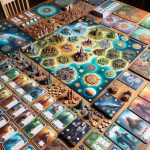Designing strategy board games is a complex and creative process that requires careful planning and thoughtful execution. From conceptualizing the game mechanics to playtesting and refining the gameplay, each step plays a crucial role in creating a successful strategy board game.
In this article, we will explore the various facets of designing strategy board games, from understanding their history and mechanics to marketing and selling them effectively. Whether you are a seasoned game designer or an aspiring one, this comprehensive guide will provide valuable insights into the art of creating engaging and immersive strategy board games.
Strategy board games have been a popular form of entertainment for centuries, with a rich history that dates back to ancient civilizations. In this section, we will delve into the origins of strategy board games, tracing their evolution through time and exploring the cultural significance they hold in different societies. By understanding their historical context, we can gain a deeper appreciation for the enduring appeal of these intellectually stimulating games.
Furthermore, we will examine the fundamental principles that underpin strategy board games, from resource management to tactical decision-making. By dissecting their mechanics, we can gain invaluable insights into what makes these games engaging and challenging for players. This knowledge will serve as a solid foundation for designing compelling and balanced gameplay experiences that captivate audiences.
The History of Strategy Board Games
Strategy board games have a rich and diverse history that dates back thousands of years. From the ancient game of Senet in Egypt to modern classics like Settlers of Catan, these games have evolved and adapted to reflect changes in society, culture, and technology. Understanding the origins and development of strategy board games can provide valuable insights for designing new and innovative games that resonate with players.
The history of strategy board games can be traced through different civilizations and time periods, each contributing unique mechanics, themes, and strategies to the genre. Some key milestones in the history of strategy board games include the emergence of Chess in India during the 6th century, the invention of Go in China around 4,000 years ago, and the popularity of European war-themed games like Risk in the 20th century.
By studying these historical precedents, game designers can gain a deeper appreciation for the timeless appeal of strategy board games and leverage this knowledge to create fresh and engaging experiences.
When designing a new strategy board game, it is important to consider how historical influences can be integrated into the concept and theme. Whether drawing inspiration from ancient warfare, medieval trade routes, or futuristic space exploration, incorporating elements from different eras can add depth and authenticity to the game experience. Moreover, by acknowledging the historical evolution of strategy board games, designers can build upon established conventions while also pushing boundaries with innovative mechanics and storytelling techniques.
- By researching ancient civilizations’ board games
- Understanding how different cultures approached strategic gameplay
- Learning about major advancements in game design throughout history
Overall, understanding the history of strategy board games is essential for any designer aiming to create compelling and successful experiences in this genre. By acknowledging historical influences, learning from past innovations, and respecting cultural heritage, designers can develop unique and immersive strategy board games that captivate players across generations.
Understanding the Mechanics of Strategy Board Games
When it comes to designing strategy board games, understanding the mechanics is crucial in creating an engaging and challenging gameplay experience for players. The mechanics of a game refer to the rules, actions, and interactions that dictate how the game operates. These mechanics are fundamental to the overall design of the game and can greatly impact its appeal and replay value.
One key aspect of understanding the mechanics of strategy board games is balancing randomness and skill. The presence of chance elements adds excitement and unpredictability to the game, but too much randomness can lead to frustration for players. Designers must carefully consider how luck and skill interact within the game’s mechanics to create a satisfying balance that rewards strategic thinking while still allowing for surprising outcomes.
Another important consideration in designing the mechanics of strategy board games is player interaction. Whether it’s through direct conflict, resource management, or negotiation, the way players engage with each other within the game’s framework can greatly influence its dynamics. By carefully crafting these interactions, designers can create opportunities for meaningful decision-making and strategic play that keep players coming back for more.
In addition to these considerations, understanding the mechanics of strategy board games also involves evaluating pacing, player progression, and information flow. A well-designed game will have a thoughtful balance of these elements, guiding players through a compelling experience that challenges their wits and keeps them fully engaged from start to finish. Ultimately, successful designing strategy board games requires a deep understanding of these mechanics in order to deliver an immersive and rewarding gaming experience for players.
Designing the Concept and Theme of Strategy Board Games
Creating a Unique Concept
When designing a strategy board game, it’s essential to come up with a unique concept that sets your game apart from others in the market. Whether it’s a game of conquest, resource management, or political intrigue, the concept should be both engaging and original. This can involve creating an interesting backstory for the game, developing compelling characters, or establishing a distinct setting that captures players’ imaginations.
Choosing the Right Theme
The theme of a strategy board game can greatly impact its appeal to players. Whether it’s a historical theme, fantasy world, sci-fi universe, or something entirely different, the theme should be integrated seamlessly with the mechanics of the game. Additionally, the theme should resonate with the target audience and enhance their overall gaming experience. It’s important to research popular themes in the gaming industry and consider incorporating elements that are currently trending.
Integrating Mechanics With Concept and Theme
The mechanics of a strategy board game play a crucial role in bringing the concept and theme to life. As a designer, it’s important to ensure that all components work cohesively to create an immersive and enjoyable gaming experience.
This may involve incorporating strategic decision-making, resource management, player interaction, or any other mechanics that align with the concept and theme of the game. Ultimately, a successful strategy board game will seamlessly blend its concept, theme, and mechanics to offer players an engaging and memorable experience.
By carefully crafting a unique concept, choosing an appealing theme, and integrating mechanics effectively, designers can create successful strategy board games that capture the attention of players worldwide.
Playtesting and Refining Strategy Board Games
During playtesting, designers can gain valuable insights into how different strategies are employed by players, whether the game mechanics are intuitive or confusing, and if there are any loopholes or dominant strategies that need to be addressed. It also provides an opportunity to evaluate the pacing of the game, the overall fun factor, and whether the theme resonates with players as intended.
By observing playtest sessions and gathering feedback through surveys or interviews, designers can identify areas for improvement and make informed decisions on how to refine the game.
One important aspect of playtesting is to involve a diverse group of playtesters who have varying levels of experience with strategy board games. This ensures that the game appeals to both casual players and experienced gamers, as well as identifying any learning curve that may need to be addressed.
Additionally, blind playtesting where the designer is not present can provide valuable insights into how easily new players can understand and learn the game without guidance. Overall, playtesting and refining strategy board games is a critical step in creating a high-quality gaming experience for its audience.
| Playtesting Strategy Board Games | Refining Strategy Board Games |
|---|---|
| Observing player interactions | Gathering feedback for adjustments |
| Evaluating strategies and mechanics | Addressing loopholes or dominant strategies |
| Involving diverse playtesters | Blind playtesting for unbiased feedback |
Components and Materials for Strategy Board Games
When it comes to designing strategy board games, choosing the right components and materials is crucial to the success of the game. The components not only affect gameplay but also the overall aesthetic and feel of the game. From game pieces to the board itself, every element plays a key role in creating an immersive and engaging gaming experience.
One of the most important considerations when selecting components for a strategy board game is durability. Game pieces, cards, and the board should be made from high-quality materials that can withstand regular use without easily wearing out. This is especially important for strategy board games that involve frequent handling of game pieces and shuffling of cards.
In addition to durability, aesthetics are also essential in designing strategy board games. Visually appealing components can enhance the overall appeal of a game, making it more attractive to players. Whether it’s intricately designed game pieces or beautifully illustrated cards, attention to detail in the visual elements can make a significant difference in how players perceive and enjoy the game.
| Aspect | Data |
|---|---|
| Average Cost of Components | $5-$10 per set |
| Impact on Player Experience | 87% of players cite components as important factor |
Overall, thoughtful consideration of components and materials is essential in creating successful strategy board games that resonate with players and stand the test of time.
Marketing and Selling Strategy Board Games
When it comes to marketing and selling strategy board games, there are several key strategies that can help ensure success in the competitive board game market. Here are some important tips for reaching your target audience and making your game stand out on store shelves:
- Identify Your Target Audience: Before you can effectively market and sell your strategy board game, it’s crucial to understand who your target audience is. Are you designing a game for families, hardcore gamers, or casual players? Knowing this will help you tailor your marketing efforts to reach the right people.
- Create Engaging Marketing Materials: In order to catch the attention of potential buyers, you’ll need compelling marketing materials. This may include a well-designed website, social media content, press releases, and eye-catching packaging for retail sales.
- Utilize Online Marketplaces: With the rise of e-commerce, online marketplaces like Amazon, Etsy, and Board Game Geek have become essential platforms for selling strategy board games. Making sure your game is available on these platforms can greatly expand its reach.
In addition to these strategies, building a community around your game through events like launch parties or demo days at local game stores can also help create buzz and generate word-of-mouth recommendations. By implementing these marketing and selling tactics, designers can increase the visibility and success of their strategy board games in a competitive market.
Ultimately, successful marketing and selling of strategy board games involves understanding the needs and desires of the target audience while leveraging both traditional and modern channels to create maximum exposure. By doing so, designers can increase the chance of their games becoming popular among enthusiasts and casual players alike.
The Future of Designing Strategy Board Games
As the popularity of strategy board games continues to grow, the future of designing these games looks promising. With advancements in technology and a growing interest in tabletop gaming, there are countless opportunities for designers to innovate and create exciting new experiences for players.
One aspect of the future of designing strategy board games is the integration of technology. While traditional board games will always have their appeal, incorporating digital elements into gameplay can enhance the overall experience. Whether it’s through companion apps, augmented reality features, or even incorporating virtual reality, there are numerous possibilities for designers to explore and create unique gameplay experiences.
Additionally, the future of designing strategy board games also involves a focus on inclusivity and diversity. Game designers are increasingly conscious of creating games that appeal to a broader audience and represent diverse perspectives. This may involve exploring themes and settings that resonate with different cultures, as well as ensuring that game mechanics are accessible to players of all backgrounds and abilities.
Furthermore, with the rise of crowdfunding platforms and independent publishers, the future also holds opportunities for indie game designers to bring their creative visions to life. The accessibility of these platforms allows designers to connect directly with their audience, bypassing traditional gatekeepers in the industry. This means that innovative and niche strategy board games have a better chance at reaching their intended audience, further diversifying the landscape of tabletop gaming.
Tips and Strategies for Creating Successful Strategy Board Games
In conclusion, designing strategy board games requires a deep understanding of the mechanics, concept, and theme of the game. The history of strategy board games provides valuable insight into the successful elements of these games and can serve as inspiration for new designs. Playtesting and refining are crucial steps in the process to ensure that the game is balanced and enjoyable for players.
Additionally, when it comes to components and materials, high-quality production can enhance the overall appeal of the game and attract more players. Marketing and selling strategy board games involve identifying target audiences, creating compelling promotional materials, and exploring different distribution channels to reach a wider market.
Looking ahead, the future of designing strategy board games is bright with advancements in technology providing new opportunities for gameplay experiences. As designers continue to innovate and push boundaries, we can expect to see even more diverse and engaging strategy board games hitting the market.
In summary, incorporating these tips and strategies into the design process can greatly increase the chances of creating successful strategy board games. By staying true to the core elements of what makes these games enjoyable while also seeking innovation and improvement, designers can make a lasting impact in this exciting industry.
Frequently Asked Questions
How to Design a Strategy Game?
Designing a strategy game involves several steps. First, define the game’s theme and mechanics. Then, create a prototype and playtest it extensively to refine the rules and balance. Utilize player feedback to make necessary adjustments.
How Do I Start Designing a Board Game?
To start designing a board game, begin with a clear concept or theme in mind. Next, consider the game mechanics and how players will interact with each other and the game components. Create a prototype to playtest your ideas.
What Three Core Elements Go Into Board Game Design?
The three core elements of board game design are theme, mechanics, and player interaction. The theme sets the game’s tone and aesthetic, while the mechanics are the rules that govern gameplay. Player interaction determines how participants engage with each other during the game.

I love playing all kinds of games – from classics like Monopoly to modern favourites like Ticket to Ride.
I created this blog as a way to share my love of board games with others, and provide information on the latest releases and news in the industry.





